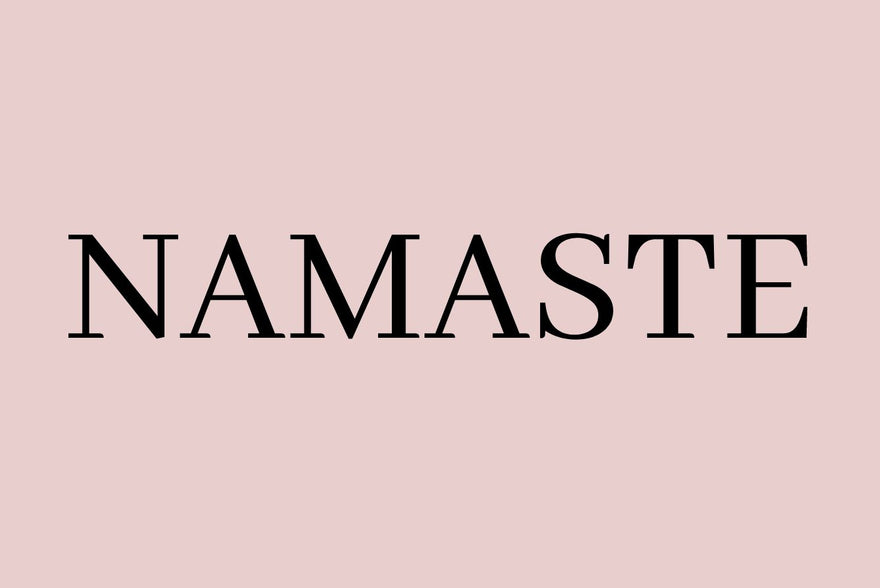Yoga, asana, pranayama, hand gestures – in yoga you will encounter a number of technical terms, most of which come from Sanskrit. First of all: You don't have to know all the terms before you can start with yoga. Nevertheless, it makes sense to know the most important yoga terms and their meaning in order to better understand the philosophy behind them and go deeper into the practice. That's why we have a yoga lexicon with the most important yoga terms for you.
Sanskrit and Yoga: The most important terms and their origin
Sanskrit is an ancient language that originated in India and is also known as a sacred language. Many terms in yoga come from Sanskrit - which is why you will come across them regularly in your yoga practice. Here comes our yoga lexicon with the most important yoga terms:
yoga
Yoga is a philosophical teaching from India that is thousands of years old. Yoga means union or integration. A holistic approach aims to bring body, mind and soul into harmony through a combination of breathing techniques, physical exercises and meditation. You can find out more about this in our detailed article on yoga .
Asana
The yoga term asana describes the many different postures and exercises that are of great importance in Hatha Yoga , for example. The term asana can often be found in the endings of the names, as in Trikonasana, the triangle. A flow is a combination of several asanas that flow smoothly into one another.
Pranayama
Prana is the breath and describes the energy that can be released through the breath. Pranayama are breathing exercises and breathing techniques that help you calm down and bring your body and mind into harmony.
Chakras
The chakras are the invisible energy centers or sources of the body. There are 7 main chakras that run from the pelvic floor to the crown of the head. Translated, chakra means circle or wheel. Each chakra is associated with certain physical and mental issues. Blocked chakras can lead to problems in the corresponding areas. In chakra teaching you can open blocked chakras through yoga and meditation.
Ayurveda
Ayurveda is the “science of life” and an ancient Indian health theory. Health is viewed holistically; central elements of Ayurveda practice are nutrition, massages and cleansing techniques, herbal medicine and yoga.
Patanjali
The Indian scholar Patanjali is the author of the Yoga Sutra, the classic textbook and guide to yoga, and is therefore considered the founder of yoga and yoga practice.
More yoga terms
You now know the most important yoga terms. You will come across other important terms at the beginning and end of a yoga class, where singing often plays a role, and in the names of the yoga exercises, the asanas.
Greetings and singing in yoga
Welcoming rituals and singing serve to get you in the mood for the yoga class and also to conclude the class. If it feels a bit strange at first, you don't have to sing along or join in with the Om. You can also just listen and let it sink in.
You may come across these yoga terms:
Mudra
Translated from Sanskrit, mudra means “seal”. Mudras are symbolic hand gestures often used during meditation, sometimes while performing asanas.
Namaste
Namaste is probably the most famous mudra. In this gesture, the palms of the hands are gently placed together in front of the chest, the thumbs touching the breastbone. Namaste literally means “I bow to you”. You will often find the variants “I honor the divine in you” or “the divine in me bows to the divine in you” a little more freely. Many yoga classes end with Namasté, but you can also use it at the beginning.
Mantra
Mantra is Sanskrit and means syllable. Mantras should become anchored in your consciousness through repetition. This is done through rhythm, vibration and sound by chanting the mantras loudly.
Om or Aum
Om or Aum is a very well-known mantra that is often found at the beginning and end of a yoga class. Om stands for the great and universal whole. Singing it loudly causes the body to vibrate through slight vibrations.

Other terms from yoga: exercises
There is a German name and a Sanskrit name for each asana. Both terms are often used in yoga courses for beginners - so you have the opportunity to learn the Sanskrit terms. We have the terms for the most important yoga exercises for you here. In our detailed article on yoga exercises you can find out more detailed information about asanas for beginners and advanced users.
- Adho Mukha Svanasana – downward dog
- Tadasana – Mountain Pose
- Balasana – Child’s Pose
- Shavasana – dead pose, relaxation sequence at the end of the yoga class
- Bhujangasana – Cobra
- Virabhadrasana – Warrior
- Surya Namaskara – Sun Salutation, not a single exercise, but the most famous yoga flow
How important are yoga terms for your yoga class?
Of course, you don't have to learn all the yoga terms by heart before you can take part in a yoga class. You have enough time to learn the terms little by little - you will notice that this happens almost automatically over time. And as you have seen, there are also German yoga terms such as for the individual yoga exercises.
